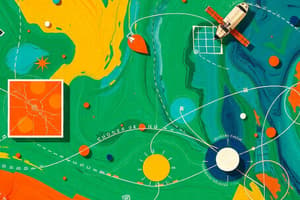Podcast
Questions and Answers
What is one cause of signal degradation in GPS systems due to environmental factors?
What is one cause of signal degradation in GPS systems due to environmental factors?
- Magnetic interference
- Thermal distortion
- Earth's atmosphere (correct)
- Mechanical vibration
Which technique helps minimize multipath errors in GPS receivers?
Which technique helps minimize multipath errors in GPS receivers?
- Signal amplification
- Signal rejection techniques (correct)
- Data filtering
- Triangulation
What is the Dilution of Precision (DOP) in relation to GPS?
What is the Dilution of Precision (DOP) in relation to GPS?
- A measure of signal strength
- A measure of satellite geometry (correct)
- A measure of receiver accuracy
- A measure of satellite availability
What impact does Selective Availability have on GPS accuracy?
What impact does Selective Availability have on GPS accuracy?
How does the Earth's atmosphere affect GPS signals?
How does the Earth's atmosphere affect GPS signals?
What characteristic of 'dual frequency' receivers helps correct for atmospheric errors?
What characteristic of 'dual frequency' receivers helps correct for atmospheric errors?
What does the acronym GPS stand for?
What does the acronym GPS stand for?
Which of the following is a characteristic of measuring longitude?
Which of the following is a characteristic of measuring longitude?
Which system is NOT part of the Global Navigation Satellite System (GNSS)?
Which system is NOT part of the Global Navigation Satellite System (GNSS)?
What analogy was used for early navigation to measure latitude?
What analogy was used for early navigation to measure latitude?
What is a marine chronometer used for?
What is a marine chronometer used for?
What is a significant challenge of measuring longitude in navigation?
What is a significant challenge of measuring longitude in navigation?
Which GNSS system is developed by Russia?
Which GNSS system is developed by Russia?
Which celestial object is used to measure latitude directly?
Which celestial object is used to measure latitude directly?
What is the primary purpose of the Coast Guard’s Differential GPS (DGPS) system?
What is the primary purpose of the Coast Guard’s Differential GPS (DGPS) system?
What role do low-level geo-synchronous satellites play in the WAAS?
What role do low-level geo-synchronous satellites play in the WAAS?
How does the WAAS enhance the accuracy of GPS signals?
How does the WAAS enhance the accuracy of GPS signals?
Which of the following datums is NOT associated with Differential GPS (DGPS)?
Which of the following datums is NOT associated with Differential GPS (DGPS)?
What geographical area does the WAAS cover?
What geographical area does the WAAS cover?
Which is a primary feature of the Wide Area Augmentation System (WAAS)?
Which is a primary feature of the Wide Area Augmentation System (WAAS)?
What is the role of Coast Guard beacons in the DGPS system?
What is the role of Coast Guard beacons in the DGPS system?
What is the primary function of the US Air Force in relation to the satellite system?
What is the primary function of the US Air Force in relation to the satellite system?
How many satellites are part of the GPS constellation?
How many satellites are part of the GPS constellation?
Which of the following statements about GPS receivers is accurate?
Which of the following statements about GPS receivers is accurate?
What is the primary purpose of the ephemeris in GPS systems?
What is the primary purpose of the ephemeris in GPS systems?
What is the basis of GPS technology?
What is the basis of GPS technology?
What is the consequence of satellites being out of sync by 1/100th of a second?
What is the consequence of satellites being out of sync by 1/100th of a second?
Which characteristic distinguishes receivers from satellites within the GPS framework?
Which characteristic distinguishes receivers from satellites within the GPS framework?
How does the travel time of radio waves impact GPS calculations?
How does the travel time of radio waves impact GPS calculations?
What speed do radio waves travel at, as indicated in the GPS context?
What speed do radio waves travel at, as indicated in the GPS context?
What is the speed of radio waves as mentioned?
What is the speed of radio waves as mentioned?
What does the time difference from a satellite to the receiver help determine?
What does the time difference from a satellite to the receiver help determine?
What type of clocks do GPS satellites utilize for accuracy?
What type of clocks do GPS satellites utilize for accuracy?
Why is precise time measurement crucial in GPS technology?
Why is precise time measurement crucial in GPS technology?
What sets the Master Station apart from the monitoring stations in the GPS Control Segment?
What sets the Master Station apart from the monitoring stations in the GPS Control Segment?
Flashcards are hidden until you start studying
Study Notes
GPS Origins and Systems
- GPS stands for Global Positioning System, developed by the U.S. Department of Defense as part of the NAVSTAR GPS.
- Global Navigation Satellite System (GNSS) includes various systems: NAVSTAR GPS (USA), GLONASS (Russia), Galileo (EU consortium), Compass (China), and IRNSS (India).
Early Navigation Techniques
- Latitude could be easily measured using the North Star (Polaris) and a sextant, determining angles like 41 degrees elevation.
- Longitude measurement required precise timekeeping; a marine chronometer allows navigators to calculate their position relative to GMT.
GPS Space Segment
- The GPS constellation comprises 24 satellites orbiting approximately 12,500 miles above Earth.
- At least four satellites are visible from any point on Earth at all times, ensuring constant location tracking.
- Satellites transmit identical signals, and distance is calculated by measuring the time delay from transmission to reception.
Timing and Signals
- Satellites utilize precise atomic clocks; inaccuracies of just 1/100th of a second can lead to significant distance errors (up to 1860 miles).
- GPS benefits from trilateration, relying on time differences rather than angular measurements used in triangulation.
GPS Control Segment
- Operated by the U.S. Air Force, this segment updates satellite ephemeris (orbital data), monitors satellite health, and maintains hardware configurations.
- Includes unmanned monitoring stations to facilitate satellite tracking and control.
User Segment
- Consists of GPS receivers, with capabilities ranging from single to dual-frequency systems.
- Receivers can gather satellite data but do not transmit data back.
Challenges and Errors
- Poor satellite geometry, multipath errors (signals reflecting off surfaces), and atmospheric delays can lead to positioning errors.
- Selective Availability, a military feature, was disabled in 2000 to improve accuracy.
Types of GPS Errors
- Atmospheric Delay: Variations in the atmosphere can alter signal speed; dual-frequency receivers are used to compensate.
- Multipath Error: Signals bouncing off obstacles can distort location readings.
- Geometric Dilution of Precision (GDOP): Satellite positioning can magnify errors based on their relative positions.
Differential GPS (DGPS)
- Enhances GPS accuracy, achieving sub-meter precision by using fixed ground reference stations.
- Raw GPS data is corrected based on various reference datums like WGS84, NAD83, and ITRF2000.
WAAS (Wide Area Augmentation System)
- Developed by the FAA to improve aircraft navigation accuracy with signals from 25 ground reference stations.
- WAAS corrects GPS signals for errors detected at the reference stations and broadcasts corrections via geosynchronous satellites.
Studying That Suits You
Use AI to generate personalized quizzes and flashcards to suit your learning preferences.




